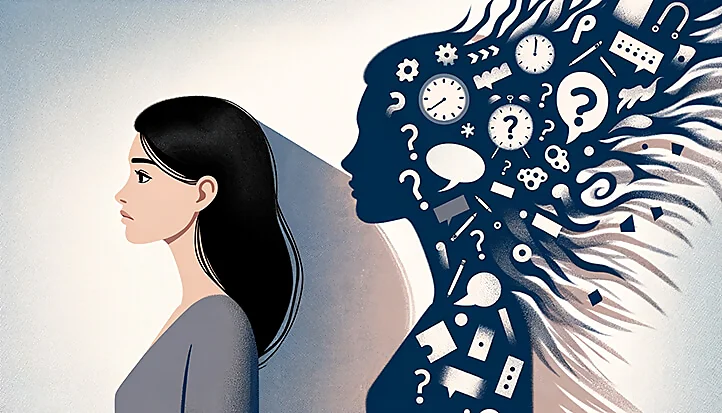Anxiety is a state of heightened worry and unease that can arise without any apparent cause or in response to specific situations. It differs from regular concern in that it is often disproportionate to the actual threat or problem. Anxiety can manifest both physically (e.g., rapid heartbeat, sweating, trembling) and psychologically (anxious thoughts, worry about the future, difficulty concentrating).
Anxiety’s impact on a person’s life can be significant, limiting their ability to perform daily tasks, work, and maintain relationships with others. Anxiety disorders may lead to avoidance of certain situations or places, which in turn can worsen isolation and feelings of loneliness. This condition can also trigger or exacerbate other mental health issues, such as clinical depression. Besides personal discomfort, anxiety can affect physical health, contributing to conditions like hypertension or heart problems due to ongoing stress and tension.
Anxiety is considered one of the most common psychological issues people face worldwide. Therefore, the question of how to overcome anxiety is quite popular. Despite the widespread nature of this individual psychological trait, it is important to note that there are effective and proven ways to combat anxiety.
From relaxation techniques and meditation to cognitive-behavioral therapy and physical exercise, a variety of strategies can help people reduce anxiety and improve their quality of life.

What is anxiety?
Anxiety is a complex emotional and physiological state characterized by feelings of worry, nervousness, and fear, often accompanied by various physical symptoms such as rapid heartbeat, sweating, and trembling. This condition can be a response to stress, specific situations, or can arise without an obvious cause.
Unlike temporary concern, which may appear in response to a specific event or problem and subsides after the stimulus disappears, anxiety often persists and can significantly interfere with daily life.
The key difference between anxiety and regular worry lies in its intensity, duration, and impact on daily activity. Regular worry is usually short-lived and directly tied to a specific problem or event that can be identified and does not have a long-term effect on a person’s functioning. Anxiety, however, may be disproportionate to the source of worry or may arise without a visible cause, accompanied by persistent or recurring anxious thoughts that are difficult to control. This makes anxiety a more profound and complex condition requiring special attention and treatment approaches.
Examples of situations and symptoms indicating an anxiety disorder
Anxiety manifests with a variety of symptoms and in different situations, affecting a person’s physical and emotional state. Here are some examples of situations and symptoms that may indicate an anxiety disorder:
Situations causing anxiety
- Social interactions. Fear of public speaking, meetings, or even everyday social interactions, leading to avoidance of such situations.
- Work or study. Excessive worry about deadlines, exams, or the quality of work, despite adequate preparation and effort.
- Health concerns. Persistent worry about one’s health or the health of loved ones, even in the absence of serious medical diagnoses.
- Everyday decisions. Heightened anxiety when making routine decisions, such as what to wear or what to order in a restaurant.
Symptoms of anxiety disorder
- Physical symptoms. Rapid heartbeat, sweating, trembling, fatigue, headaches, muscle tension, or body aches.
- Emotional symptoms. Constant worry or anxiety, expecting the worst, irritability, difficulty concentrating.
- Behavioral changes. Avoidance of situations that may cause anxiety, social isolation, trouble falling asleep or sleep disturbances.
- Panic attacks. Sudden, intense bouts of fear or discomfort, accompanied by palpitations, sweating, trembling, shortness of breath, dizziness, or loss of control.
If you or someone close to you experiences these symptoms regularly, it may indicate the presence of an anxiety disorder. In this case, it’s important to seek professional help, as there are effective and proven ways to overcome anxiety.

Method 1: Relaxation Techniques
In today’s world, where the pace of life relentlessly accelerates and each day brings new challenges, overcoming anxiety has become not just a useful skill but a necessity for maintaining emotional well-being and physical health. One of the most accessible and effective approaches to reducing anxiety is the use of relaxation techniques, which not only help to alleviate immediate anxiety symptoms but also, in the long term, teach the body to respond more calmly and balanced to stressful situations.
These techniques do not require special conditions or significant time investment, making them easy to integrate into daily life. Regular use of relaxation techniques not only helps reduce anxiety but also improves overall quality of life by increasing personal effectiveness and satisfaction.
Breathing Exercises and Meditation
Breathing exercises and meditation are two key methods for combating anxiety disorders that help restore inner calm and reduce stress levels. These techniques can be learned and practiced independently. They are considered accessible and effective tools for those looking to overcome anxiety.
Breathing Exercises
The foundation of breathing exercises is the conscious regulation of breathing aimed at reducing the body’s physiological response to stress. The key element is slowing and deepening the breath, which helps activate the parasympathetic nervous system, responsible for the “rest and digest” response. A simple breathing exercise is the “4-7-8” technique, which is performed as follows: a full inhale through the nose for a count of “four,” hold the breath for a count of “seven,” and a slow exhale through the mouth for a count of “eight.” This rhythm helps reduce heart rate and blood pressure, bringing a sense of calm and relaxation.
Meditation
Meditation is a practice that involves focusing attention, helping to reduce the flow of anxious thoughts and emotional tension. There are many forms of meditation, including mindfulness, transcendental meditation, breath meditation, and meditative practices using mantras. The general principle is to train the mind to remain in the present moment, avoiding anxious thoughts about the future or the past. Regular meditative practice helps reduce stress levels, improve concentration, and enhance overall emotional well-being.
Using breathing exercises and meditation as methods for combating anxiety allows for deep relaxation and inner calm. These practices require no special equipment, making them easily accessible tools for improving quality of life.
To fully harness the potential of breathing exercises and meditation in the fight against anxiety, it is important to incorporate these practices into your daily routine and follow certain recommendations for best results.
For breathing exercises:
- Start with short sessions. When learning breathing techniques, begin with short practices lasting 2-3 minutes and gradually increase the time to 10-15 minutes per day.
- Choose a quiet place. Practice breathing exercises in a quiet and peaceful environment where you won’t be disturbed.
- Focus on your breathing rhythm. Pay attention to each inhale and exhale to enhance the relaxation effect.
- Use visualization. Imagine that with each inhale, you are absorbing calmness, and with each exhale, you are releasing tension and anxiety.
For meditation:
- Set a regular time for practice. It’s best to meditate at the same time each day to create a stable habit, for example, morning meditation after waking up can help set a positive tone for the day, while evening meditation before sleep can help relieve accumulated stress.
- Find a comfortable position. Choose a comfortable position for meditation, whether sitting on a chair with a straight back or in the lotus position on a cushion. The main thing is that your position is stable and comfortable throughout the session.
- Use meditation apps or guides. For beginners, specialized apps and audio guides can be useful to learn the basics of meditation.
- Practice mindfulness in everyday life. Mindfulness meditation does not necessarily require separate time for practice. You can practice it while performing everyday actions, for example, during meals or walks, by focusing on sensations and experiences in the present moment.
Remember that regularity and consistency in breathing exercises and meditation play a key role in achieving positive results. Don’t be discouraged if you don’t feel relief immediately, as managing anxiety takes time and patience.

Method 2: Cognitive Behavioral Therapy (CBT)
Cognitive Behavioral Therapy (CBT) is one of the most effective and extensively researched approaches in treating anxiety. Based on the assumption that our thoughts, feelings, and behaviors are interconnected, CBT aims to identify and change negative and distorted thought processes that may trigger or worsen anxious states. Psychotherapy helps individuals recognize how certain cognitive patterns can lead to anxious behaviors and teaches strategies to respond more appropriately to stressful situations.
Research shows that CBT is one of the most effective methods for treating various forms of anxiety, including generalized anxiety disorder, panic attacks, social phobia, and other specific phobias. One of the key features of CBT is its focus on developing skills that patients can use in daily life to manage anxiety, contributing to the long-term maintenance of the results achieved.
Patients who undergo cognitive behavioral therapy often show significant improvements, including a reduction in anxiety symptoms and an overall enhancement in the quality of life. CBT has also proven effective in reducing the likelihood of relapse in anxiety disorders, making it a valuable tool not only for short-term relief of symptoms but also for long-term anxiety management.
Examples of Cognitive Distortions Affecting Anxiety and Ways to Correct Them
Cognitive distortions are irrational thought processes that distort the perception of reality, often leading to increased anxiety and emotional disturbances. Recognizing and correcting these distortions is a key element of Cognitive Behavioral Therapy (CBT). Below are examples of common cognitive distortions that affect anxiety, along with ways to correct them:
Catastrophizing
- What it is: Exaggerating the likelihood and consequences of potential negative events, assuming the worst will inevitably happen.
- Correction: Ask yourself questions to assess the real probability of the event and its possible outcomes. For example: “What evidence is there that the worst will really happen? What are some more realistic outcomes?”
Black-and-White Thinking
- What it is: Perceiving situations in extremes, without considering intermediate shades or alternatives.
- Correction: Try to find middle ground or aspects of the situation that don’t fit the extremes. Ask yourself: “Are there examples where the outcome wasn’t as terrible as I’m assuming?”
Personalization
- What it is: Tendency to see yourself as responsible for events outside your control.
- Correction: Realize that not everything in the world happens because of you or your actions. Ask yourself: “Is there evidence that I am truly fully responsible for this?”
Filtering
- What it is: Focusing only on the negative aspects of a situation while ignoring the positive ones.
- Correction: Consciously seek and acknowledge the positive aspects of each situation. Ask yourself: “What positive elements can I find in this situation?”
Fortune-Telling
- What it is: Assuming that something bad will inevitably happen, without real grounds for such an assumption.
- Correction: Focus on facts, not hunches. Ask yourself: “What evidence supports or refutes my assumption?”
By working on correcting these distortions, you can significantly reduce anxiety and improve overall psychological well-being. It takes practice and patience, but over time it can lead to a more rational and balanced perception of yourself and the world around you.

Method 3: Physical Activity
Regular physical exercise has a significant impact on reducing anxiety levels, as confirmed by numerous studies. This effect is achieved through various physiological and psychological mechanisms:
- Release of endorphins. Exercise stimulates the production of endorphins — “happiness hormones,” which naturally improve mood and reduce pain sensations.
- Reduction of stress hormones. Regular workouts help lower cortisol and adrenaline levels, the stress hormones, thereby reducing feelings of anxiety.
- Improved sleep. Physical activity promotes better sleep, which plays a critical role in regulating mood and anxiety.
- Neuroplasticity. Exercise stimulates brain neuroplasticity, enhancing its functions and strengthening mechanisms responsible for reducing anxiety.
- Boosting self-esteem. Engaging in sports improves body image and boosts self-esteem, which in turn reduces anxiety levels.
- Distraction. Physical activity distracts from anxious thoughts, allowing the brain to “reboot” and reduce feelings of worry.
- Sense of control. Regular workouts strengthen feelings of personal control and self-efficacy, which are powerful antidotes to anxiety.
- Social support. Group sports or fitness activities provide important social support and a sense of belonging.
- Consistency. Even moderate physical activity, such as walking, yoga, or light aerobics, can significantly reduce anxiety levels when performed regularly.
- Enjoyable activity. It is important to choose a type of physical activity that is enjoyable, as this increases the likelihood of maintaining a consistent routine.
Overall, physical exercise represents an accessible, effective, and natural way to manage anxiety, which can be used both independently and in conjunction with other treatment methods.
Tips for Incorporating Physical Activity into Your Daily Routine
Incorporating physical activity into your daily routine may seem challenging, especially with a busy schedule and numerous responsibilities. However, there are simple and effective ways to make exercise a part of your everyday life:
- Short sessions. Start with short workouts lasting 10-15 minutes a day and gradually increase their duration.
- Simple exercises. Include simple exercises in your routine, such as walking, stretching, or light aerobics, which require no special equipment and can be done at home.
- Scheduling. Write down workouts in your calendar or planner as important appointments to give them the attention and time they deserve.
- Preparation. Prepare your sportswear and equipment in advance to avoid excuses and save time.
- Active commuting. Use the stairs instead of the elevator, walk or bike instead of driving whenever possible.
- Active breaks. Stand up and do short physical exercises or stretching every hour, especially if your job involves prolonged sitting.
- Explore different sports. Experiment with various forms of physical activity to find what you truly enjoy, whether it be dancing, swimming, yoga, or cycling.
- Group activities. Exercise with friends or family; this not only makes workouts more enjoyable but also boosts your motivation.
- Specific goals. Set specific, measurable, achievable, relevant, and time-bound (SMART) goals for your physical activity to track progress and stay motivated.
- Apps and trackers. Use mobile apps and specialized devices to monitor your activity, set goals, and receive reminders for workouts.
By incorporating physical activity into your daily routine, you will not only improve your health but also reduce stress and anxiety levels, enhance your mood, and promote overall well-being.

Method 4: Sleep Regulation
Adequate sleep plays a critically important role in managing and reducing anxiety levels. Lack of sleep or poor sleep quality can significantly intensify feelings of anxiety, while regular, quality rest helps diminish its manifestations. Here are some key aspects highlighting the importance of sleep in reducing anxiety:
- Impact on brain processes. Sleep facilitates the restoration and strengthening of neural connections in the brain, which is vital for processing emotions and stress. During deep sleep phases, the brain actively works on processing the emotional experiences of the day, helping to lower anxiety levels and improve emotional responses to stressful situations.
- Emotion regulation. Lack of sleep can increase emotional reactivity, making a person more susceptible to stress and anxious thoughts. Quality sleep helps regulate mood and reduces the risk of developing anxiety disorders and depression.
- Influence on stress hormones. Poor sleep elevates cortisol levels, the stress hormone, which can, in turn, increase feelings of anxiety. Regular, adequate sleep helps maintain hormone balance related to stress, promoting a calmer and more relaxed state.
- Improvement of cognitive functions. Sleep is important for cognitive functions such as attention, concentration, memory, and problem-solving. Lack of sleep can impair these functions, increasing anxiety and making it difficult to cope with stressful situations. Quality sleep helps maintain mental clarity and effective decision-making.
Recommendations for Improving Sleep Quality and Establishing a Proper Routine
To improve sleep quality and create an effective rest routine, it is important to follow a series of recommendations that will help establish healthy sleep habits:
- Consistency. Try to go to bed and wake up at the same time every day, including weekends. This helps regulate your internal biological clock and improves sleep quality.
- Relaxation. Develop an evening ritual that helps your body and mind prepare for sleep, such as reading a book, taking a warm bath, or doing light relaxation exercises.
- Comfort. Ensure that your bedroom is quiet, dark, and cool. Use a comfortable mattress and pillows. If necessary, use earplugs or a sleep mask to create the ideal environment for nighttime rest.
- Caffeine and nicotine. Try to avoid caffeine and nicotine for several hours before bedtime, as they can disrupt sleep.
- Alcohol. Although alcohol may help you fall asleep faster, it disrupts sleep phases, making it less restorative.
- Short naps. If you nap during the day, limit it to 20-30 minutes and avoid napping in the evening to prevent nighttime sleep disruption.
- Regular exercise. Regular physical activity helps improve sleep quality and duration. However, avoid intense workouts right before bedtime.
- Relaxation techniques. Practices such as meditation, deep breathing, and yoga promote stress reduction and improve sleep.
- Screen light. Avoid using electronic devices for an hour before bedtime, as screen light can disrupt circadian rhythms.
By following these recommendations, you can significantly improve sleep quality, overall health, reduce anxiety levels, and enhance energy and mood.

How to Overcome Anxiety: Possible Obstacles
Overcoming anxiety can be challenging due to a number of obstacles that seem insurmountable to many people. However, with the right approaches and strategies, it is possible to achieve the goal of overcoming anxiety disorders:
- Lack of motivation. Set small, achievable goals to gradually increase motivation. Record your achievements and mark even the slightest progress in combating anxiety. Discuss your goals and achievements with friends, family, or a psychologist who can offer support and praise.
- Fear of failure. View failures as part of the learning process and opportunities for growth, rather than the end of the road. Use cognitive-behavioral strategies to combat negative self-perception and change your thoughts.
- Avoidance of frightening situations. Break down the process of overcoming frightening situations into small, manageable steps and gradually confront your fears. Gradual and controlled exposure to fear-inducing objects helps reduce anxiety.
- Lack of time. Make your mental health a priority by setting aside time for relaxation, exercise, and other healthy habits. Find ways to integrate anxiety-reducing practices into your daily routine, such as meditation during lunch breaks.
- Fear of judgment from others. Strengthen your self-esteem and self-confidence through positive self-perception and achievements. Surround yourself with supportive people who understand your struggle with anxiety.
- Lack of access to informational resources. Utilize available online resources, including webinars, articles, videos, and anxiety-reducing apps. Consider affordable psychotherapy options, including group therapy, flexible payment systems, or community mental health services.
Overcoming these obstacles requires time, patience, and consistency. Remember that progress may be nonlinear, and every step forward is a significant achievement on the path to reducing anxiety.

Conclusion
Overcoming anxiety requires active and conscious efforts, as well as taking steps aimed at improving one’s mental health. The importance of active actions in this process cannot be overstated, as they form the basis for effective management of anxiety disorders and a return to a full life.
Active actions include developing and maintaining healthy habits such as regular physical exercise, a balanced diet, adequate and quality sleep, as well as mindfulness and meditation practices. Additionally, it is crucial to strive for the development of stress-coping skills, learning to respond calmly and productively to challenging situations.
Utilizing cognitive-behavioral therapy (CBT) and other forms of psychotherapy can help identify and correct negative thinking patterns that sustain anxiety. It is also important to be open to learning new strategies for coping with anxiety and applying them in daily life.
Engaging in social activities and maintaining strong social connections can significantly improve emotional well-being and reduce feelings of isolation that often accompany anxiety. Seeking support from friends, family, or specialized support groups is also a key aspect of successfully combating anxiety disorders.
It is important to remember that the process of overcoming anxiety is a marathon, not a sprint. It requires time, patience, and consistency in applying active actions to achieve sustainable changes. Taking responsibility for one’s mental health and making efforts to improve it demonstrates strength and determination on the path to well-being and psychological resilience.
Furthermore, when overcoming anxiety, it is essential to understand that seeking professional help is not a sign of weakness but rather a demonstration of strength and a desire to improve the quality of one’s life. Psychologists, psychotherapists, and other mental health professionals possess the necessary knowledge and experience to offer effective treatment methods.
If you feel that anxiety interferes with your daily life, do not hesitate to seek help. A psychologist can help you understand the roots of your anxiety, teach you how to cope with anxious thoughts and emotions, and develop a personalized treatment plan tailored to your individual needs.
It is also important to know that there are various forms of support, including individual therapy, group therapy, online consultations, and self-help programs. This means that you can choose the option that best suits you based on your preferences, schedule, and financial possibilities.
Deciding to seek help is the first step on the road to recovery. Do not let prejudices or the fear of judgment from others prevent you from obtaining the necessary support. Your mental health is a priority, and taking care of it is an investment in future happiness and well-being.

Recommended Literature
- “The Anxiety and Phobia Workbook” by Edmund J. Bourne.
This book is a comprehensive guide to understanding and managing anxiety. It includes information on various types of anxiety disorders, relaxation strategies, stress management techniques, and cognitive methods for combating anxious thoughts. - “Overcoming Anxiety: A Self-Help Guide Using Cognitive Behavioral Techniques” by Helen Kennerley.
This book is a practical guide to cognitive-behavioral therapy (CBT) for people suffering from anxiety. The author provides readers with strategies and exercises to work on their anxious thoughts and behaviors to reduce the impact of anxiety on their lives. - “The Power of Now: A Guide to Spiritual Enlightenment” by Eckhart Tolle.
Although this book is not a guide to combatting anxiety in the strict sense, it helps readers find inner peace and reduce anxiety through mindfulness and living in the present moment. The author shares profound reflections on how to stop worrying about the future and live here and now. - “Facing Love Addiction: Giving Yourself the Power to Change the Way You Love” by Pia Mellody, Andrea Wells Miller, and J. Keith Miller.
This book explores the roots of anxiety and offers methods for overcoming it through personal growth and self-discovery. The authors discuss how anxiety disorders can affect interpersonal relationships and propose strategies for creating healthier and more harmonious connections. - “How to Stop Worrying and Start Living” by Dale Carnegie.
A classic book that offers proven ways to combat anxiety and stress. Carnegie provides practical real-life advice that helps readers reduce worry and enjoy life.




